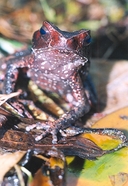|
Rhaebo haematiticus (Cope, 1862)
| family: Bufonidae genus: Rhaebo |
 © 2009 Eduardo Boza Oviedo (1 of 34) |
|
|
|
Description The head is as broad as it is long with large parotoid glands that are elongated, equal in area to the side of the head, and covered with pustulate warts. No cranial crests are present. Limbs are long. Finger I is longer than finger II; no webbing on any fingers. Single subarticular tubercles are present but supernumerary and accessory palmar tubercles are lacking. Toes are webbed at the base, with single rounded subarticular tubercles on the toes but no supernumerary or plantar tubercles. Inner metatarsal tubercle elongated, outer metatarsal tubercle small and rounded. There is a distinct inner tarsal fold. Dorsal surfaces and parotoid glands have warts and pustules. Adult males have a single internal subgular vocal sac that is fully distensible and a single vocal slit on either right or left. On the thumb, males have a brown nuptial pad (Savage 2002). The dorsum has a coloration of tan to purplish gray, which may be uniform or marked with black spots and/or burnt orange blotches. The parotoids are a slightly lighter shade than the dorsum. The iris is dark brown to black with gold flecks. A white line outlines the top of a dark brown-black lateral stripe that runs from the tip of the snout along the side of the head and flank to the groin. The venter is light beige to yellow, often shading into burnt orange with dark brown marks on the chest (Savage 2002). Larvae are small with an ovoid and somewhat depressed body, reaching 21 mm in total length at stage 37. Mouth is anteroventral, nostrils anterolateral, and eyes are dorsal. Lateral, sinistral spiracle, and medial vent tube. Tail long with low fins and a rounded tip. Oral disc small and emarginate, with beaks and 2/3 denticles, showing a broad A2 gap above the mouth. A single row of labial papillae is present lateral to the mouth. Dark brown dorsal coloration with clear venter. Dark tail musculature with clear fins (Savage 2002). Distribution and Habitat Country distribution from AmphibiaWeb's database: Colombia, Costa Rica, Ecuador, Honduras, Nicaragua, Panama, Venezuela
Life History, Abundance, Activity, and Special Behaviors Bufo haematiticus consumes small ants, mites, beetles, and other arthropods ranging from 0.4 to 4.8 mm in length (Savage 2002). Trends and Threats The main threats are habitat destruction and degradation due to agriculture, cattle ranching, and wood extraction, although this species does occur in several protected areas. It can sometimes be found in disturbed habitat as long as intact forest is adjacent. In Venezuela its habitat is threatened by dams and in Colombia oil pollution is a problem. Chytrid fungal infections have been detected in this species at Fortuna, Panama (Solís et al. 2004). Possible reasons for amphibian decline General habitat alteration and loss Comments A Spanish-language species account can be found at the website of Instituto Nacional de Biodiversidad (INBio).
References
Barrio-Amorós, C. L. (2004). ''Amphibians of Venezuela, Systematic list, distribution and references: an update.'' Revista Ecología Latinoamericana, 9, 1-48. Bogart, J. P. (1972). ''Karyotypes.'' Evolution in the Genus Bufo. W. F. Blair, eds., University of Texas Press, Austin. Ibañez, R., Rand, A. S. and Jaramillo, C. A. (1999). Los Anfibios del Monumento Natural Barro Colorado, Parque Nacional Soberanía y Areas Adyacentes. Mizrachi, E. and Pujol, S. A., Santa Fe de Bogota. Pounds, J. A., Fogden, M. P. L., Savage, J. M., and Gorman, G. C. (1997). "Tests of null models for amphibian declines on a tropical mountain." Conservation Biology, 11(6), 1307-1322. Savage, J. M. (2002). The Amphibians and Reptiles of Costa Rica:a herpetofauna between two continents, between two seas. University of Chicago Press, Chicago, Illinois, USA and London. Solís, F., Ibáñez, R., Jaramillo, C., Chaves, G., Bolaños, F., Savage, J., Cruz, G., Wilson, L.D., Köhler, G., Coloma, L.A., Ron, S., García-Pérez, J.E., and Amézquita, A. (2004). Rhaebo haematiticus. In: IUCN 2009. IUCN Red List of Threatened Species. Version 2009.1. www.iucnredlist.org. Downloaded on 28 July 2009. Originally submitted by: Lettie Gallup (first posted 2009-07-15) Edited by: Kellie Whittaker (2009-11-02) Species Account Citation: AmphibiaWeb 2009 Rhaebo haematiticus <https://amphibiaweb.org/species/191> University of California, Berkeley, CA, USA. Accessed May 29, 2025.
Feedback or comments about this page.
Citation: AmphibiaWeb. 2025. <https://amphibiaweb.org> University of California, Berkeley, CA, USA. Accessed 29 May 2025. AmphibiaWeb's policy on data use. |




 Map of Life
Map of Life